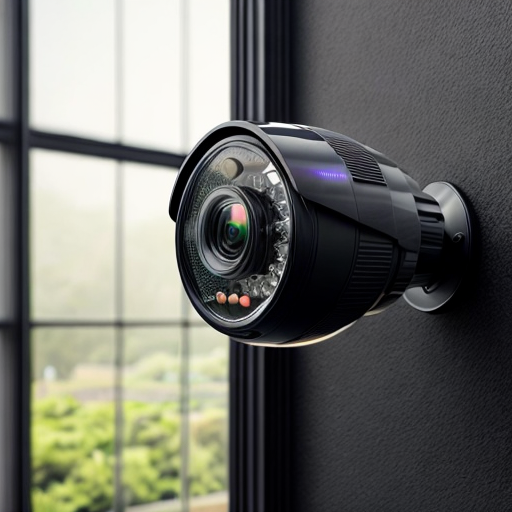The Early Beginnings: The Birth of Home Security Cameras
Once upon a time, in a land not too far away, someone had the brilliant idea of keeping an eye on their castle while they were out slaying dragons or rescuing princesses. And thus, the birth of home security cameras came to be. It all started way back in the 1940s, when some clever folks decided that they needed a way to keep their homes safe from mischievous burglars and nosy neighbors. These early pioneers of security thought, 'Why not have a magical device that can capture all the shenanigans happening outside our humble abodes?' And just like that, the first home security camera was born, ready to document every suspicious squirrel and daring squirrel heist. From that moment on, homes everywhere became a little bit safer, and the world of surveillance took a giant leap forward.
From Analog to Digital: The Evolution of Home Security Cameras
An interesting fact about the invention of home security cameras is that the concept dates back to the late 19th century. In 1891, a man named Louis Le Prince, who is often credited as the 'Father of Cinematography,' developed a device called the 'Single Lens Camera.' While primarily designed for capturing motion pictures, this camera could also be used for surveillance purposes. Le Prince's invention laid the foundation for the modern-day home security camera systems that we rely on today.
Picture this: it was the swinging 1960s, and the world was grooving to the beat of change. In the midst of this cultural revolution, home security cameras were quietly evolving from clunky analog contraptions to sleek digital wonders. It was the 1970s when the first digital home security camera made its grand entrance, bringing with it the promise of clearer images and easier surveillance. No longer were homeowners stuck with grainy footage that resembled a blurry Picasso painting; now, they could capture every detail with crystal-clear precision. As technology continued to advance, these cameras became smaller, smarter, and more accessible to the average Joe. Suddenly, protecting one's castle became as simple as a click of a button, and the era of digital home security cameras was officially in full swing.
The Rise of DIY Surveillance: Home Security Cameras in the Modern Era

In the not-so-distant past, the idea of having a home security camera system seemed like something out of a James Bond movie. But oh, how times have changed! With the advent of the modern era, home security cameras have become more accessible than ever, thanks to the rise of DIY surveillance. It all began in the late 1990s when technology took a giant leap forward, and home security cameras became more affordable and user-friendly. Suddenly, homeowners could take matters into their own hands and set up their very own surveillance systems without breaking the bank.
Gone were the days of relying on expensive professional installation or complicated wiring. Now, all it took was a quick trip to the local electronics store, a few YouTube tutorials, and voila! You had yourself a DIY surveillance system. The beauty of this newfound accessibility was that anyone, from tech-savvy enthusiasts to everyday homeowners, could take charge of their home security.
As the 2000s rolled in, the market for home security cameras exploded. Companies began offering a wide range of options, from wireless cameras that could be easily mounted anywhere to smart cameras that could be controlled with a smartphone. Suddenly, homeowners had the power to monitor their property from anywhere in the world, whether they were at work, on vacation, or simply lounging on the couch.
With each passing year, home security cameras continued to evolve, becoming more advanced and sophisticated. High-definition video, motion detection, night vision, and even facial recognition became standard features. The modern era had truly ushered in a new age of DIY surveillance, empowering homeowners to protect their castles with ease and peace of mind.
In conclusion, the invention of home security cameras dates back to the mid-20th century, but it is in the modern era that they have truly come into their own. From their humble beginnings as clunky analog devices to the sleek and smart cameras of today, the rise of DIY surveillance has revolutionized home security. Now, anyone can be their own secret agent, keeping a watchful eye on their property and ensuring the safety of their kingdom.
Innovations and Future Trends: Advancements in Home Security Camera Technology
A fun fact about home security cameras is that the first known patent for a home security camera system was filed in 1969 by Marie Van Brittan Brown, an African-American nurse from New York City. Her invention included a closed-circuit television system that could transmit video images from peepholes to a monitor, allowing homeowners to see who was at their door without opening it. This pioneering invention laid the foundation for modern home security camera systems that we use today.
Since their inception in the mid-20th century, home security cameras have come a long way, and the innovations and future trends in this technology continue to amaze. From the early days of grainy footage to the crystal-clear high-definition video we have today, the advancements in home security camera technology have been remarkable. But the journey doesn't stop there. As we look to the future, we can expect even more exciting developments. From artificial intelligence-powered cameras that can recognize and differentiate between humans and animals to cameras equipped with facial recognition technology, the possibilities are endless. With each passing year, home security cameras become smarter, more intuitive, and more integrated into our daily lives, ensuring that our homes remain safe and secure in the face of ever-evolving threats.

